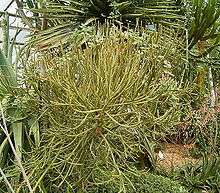Euphorbia arbuscula
Euphorbia arbuscula is a species of plant in the spurge family (Euphorbiaceae).[2] It is endemic to the archipelago of Socotra in Yemen. Its natural habitats are subtropical or tropical dry forests and subtropical or tropical dry shrubland.[1]
| Euphorbia arbuscula | |
|---|---|
 | |
| Scientific classification | |
| Kingdom: | Plantae |
| Clade: | Tracheophytes |
| Clade: | Angiosperms |
| Clade: | Eudicots |
| Clade: | Rosids |
| Order: | Malpighiales |
| Family: | Euphorbiaceae |
| Genus: | Euphorbia |
| Species: | E. arbuscula |
| Binomial name | |
| Euphorbia arbuscula | |
| Synonyms[2] | |
|
Tirucallia arbuscula (Balf.f.) P.V.Heath | |
Scottish botanist Isaac Bayley Balfour described this species in 1884 from material collected from the Yemeni island of Socotra, where he recorded it was common.[3] The species name is derived from the Latin adjective arbusculus "small tree".[4] Two subspecies are recognised.[5] Balfour had visited Socotra in 1880 and collected many plants.[6] Within the large genus Euphorbia it is classified in the subgenus Euphorbia section Tirucalli.[7]
The nominate subspecies arbuscula has a tree-like habit, reaching 6 m (20 ft) tall. It has cylindrical greyish green branches. Subspecies montana is smaller, reaching 2 m (7 ft) in height.[5] There are leaves only on the newest shoots, the plants' other greener branches photosynthesise sunlight instead.[6]
The leaflets are eaten by goats, both when the leaves are dried out and when they are green and fresh.[8] For that reason, this species is often planted near settlements.[1] Herders who seek to harvest food for their herd should avoid chopping off whole branches, or violently beating the branches to knock off the leaflets, in which case the plant is less likely to recover.[8] This plant flowers during the hot, dry season and is able to survive severe drought, assuming it is not abused by herders.[1] Its pores close during the day, to minimize transpirational water-loss, as part of its crassulacean acid metabolism (CAM).[9]
When cut or injured, this plant exudes a caustic latex that can burn the skin of a human who is not adequately protected.[8] The latex from this plant is useful for veterinary, medicinal, and other purposes such as for fishing.[8]
| Wikimedia Commons has media related to Euphorbia arbuscula. |
Footnotes
- Miller, A. (2004). "Euphorbia arbuscula". IUCN Red List of Threatened Species. 2004: e.T37869A10082664. doi:10.2305/IUCN.UK.2004.RLTS.T37869A10082664.en.
- "Euphorbia arbuscula Balf.f." Plants of the World Online. The Trustees of the Royal Botanic Gardens, Kew. n.d. Retrieved July 31, 2020.
- Balfour, Isaac Bayley (1884). "Diagnoses plantarum novarum phanerogamarum Socotrensium etc". Proceedings of the Royal Society of Edinburgh. 12: 76–97 [93–94]. doi:10.1017/S0370164600000195.
- Eggli, Urs (2004). Etymological Dictionary of Succulent Plant Names. Springer Science & Business Media. p. 14. ISBN 9783540004899.
- Eggli, Urs (2002). Illustrated Handbook of Succulent Plants: Dicotyledons. Springer Science & Business Media. p. 109. ISBN 9783540419662.
- Mies, Bruno (1995). "On the comparison of the flora and vegetation of the island groups of Socotra and Macaronesia" (PDF). Boletim do Museu Municipal do Funchal: 455–71.
- Bruyns, Peter V.; Mapaya, Ruvimbo J.; Hedderson, Terrence (2006). "A New Subgeneric Classification for Euphorbia (Euphorbiaceae) in Southern Africa Based on ITS and psbA-trnH Sequence Data". Taxon. 55 (2): 397–420. doi:10.2307/25065587. JSTOR 25065587.
- “Traditional Soqotran poetry:A Poem to Euphorbia” Discorida issue 1, March 2003 retrieved on 23 December 2016.
- Brown, Gary and Mies, Bruno. Vegetation Ecology of Socotra, p. 97 (Springer, 2012).
Bibliography and further reading
- Jacobsen, Hermann. Abromeitiella to Euphorbia, p. 408 (Blandford Press, 1960).
- Burgess, Neil. Terrestrial ecoregions of Africa and Madagascar: a conservation assessment, p. 413 (Island Press, 2004).
